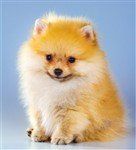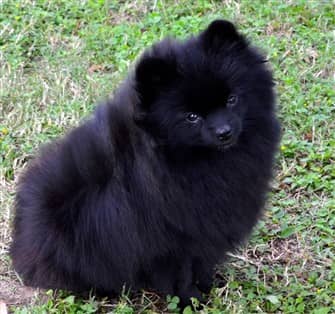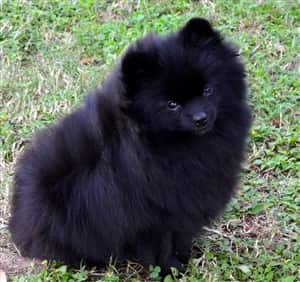Black Pomeranians
Overview
A black Pomeranian is one of the most popular of this breed. With this being said, there are many
colors that are favored by owners and that includes parti's (more than one color combination).
But, what makes a black Pomeranian?
If a Pom has a bit of color other than black, is he or she still considered to be that color? What about color changes that can occur during the time of puppy-hood to adult dog when the puppy coat sheds off to reveal the adult fur?
And then, there is the question and element of blues...
Lastly, does the hue of the coat affect any care issues such as grooming? Bathing? Shedding?
This page is to explain all of the above questions and issues and hopefully help you understand more about this particular hue. So, if you already have a black Pomeranian or you are thinking about getting one, we welcome you to stay a while and enjoy your read!
The Introduction of Color
Pomeranians descended from the ancient white Spitz sled dog, that was quite similar in appearance to the American Eskimo dog.
These medium to large sized dogs had light coats; some were pure white coats and others a light cream, light gray, etc. ... So how is it that the Poms we know of today can be found in so many colors... And how do black Pomeranian exist when they are the exact opposite coloring of the dog's ancestors?
There are some things that we know, and unfortunately due to a lack of record keeping, there are some things that we do not know. There is a gap in information, most essentially during the time that coloring was introduced.
We do know that the Spitz was bred down in size. Then, at some point color was brought in, and it is only logical to assume that this was done by introducing another breed that did have coloring. If so, it is highly likely that other dogs in the Spitz family were used.
There was a brief mention of a Pomeranian in 1764; though his coloring was not known.
Records appear again, letting us know that in the late 1800's Queen Victoria owned several Poms (one reported as being red). She loved the breed, established kennels and worked to make the breed even smaller than the 12 pound Pomeranian that she had at the time.
She was successful and she is given credit for the toy sized breed we know of today and a lot of the wonderful color assortments.
Examples of Different Types of Black Pomeranians
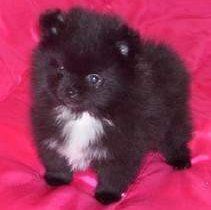
This Pomeranian puppy is indeed black; but is not a solid of course. The small patch of white that you see on his chest makes this Pom a 'black mis-mark'. Mismark refers to a patch of white that is too small to move the Pom into the parti color category. Photo courtesy of Sharp Poms.

A rare, solid black Pomeranian. As you can see, there is no other color or marking on the coat whatsoever. This is an official solid black. Solid colors like this are rare with the Pomeranian breed, because there are so many colors in the bloodline. Photo courtesy of Keen Pomeranians.
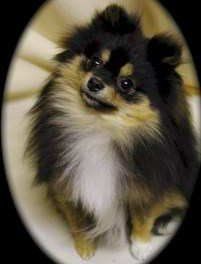
This is a lovely black/tan/white Pom. When there are 3 colors in the coat, this is known as a tri-color. However, some may dub this Pom a black and white, with tan markings. Both would be correct and it really is a matter of a breeder's preference. Photo courtesy of Mandy Jo's Poms
True Solid Black Pomeranians
True black Pomeranians will have black skin pigmentation. Eye rims, lips, nose, and paw pads will be black.
Some owners, potential owners (and even some inexperienced breeders) can become a bit confused over what constitutes a true black Pomeranian dog. Many incorrectly label dogs as being black when in fact - technically - they are not.
An official black Pom is fully black. There are no other colors at all. They also have black pigmentation on the skin: lips, eye rims, paw pads and nose.
Poms that are incorrectly dubbed black:
Dogs with a touch
of another color - here are some examples:
- If a Pom has a black body and has tan paws, the dog is black and tan.
- If a Pomeranian has a touch of white on the chest, he is a black mis-mark or a black with white markings (depending on the size of the white). If the puppy matures and his coat loses that touch of white, leaving a fully solid black body, he would be registered as a black mis-mark, but would be a solid black as an adult.
- If a Pomeranian is mostly black with a touch of white and a touch of tan, he is a tri-colored Pom (black, tan, white).
Sable -
A sable Pom
has a brown, orange, or other colored coat with black on the tips of each hair. Sometimes, if the sable is very dark and very thick, the coat may appear black. The overall 'feel' may be black, but this is not the same as a true black coat.
Blue-
This coat is a watered down, diluted black. Blues are designated as so due to skin pigmentation. The coat may very well appear to be black; however if - in bright sunlight - the nose is blue
(that diluted black), the Pom will be a blue. It is rare for anyone to dub a blue a black since blue is a very rare color, and therefore would be seen as more desirable by many.
Black Coat Color Changes
It is not unusual for a Pom puppy to change color during during his first year; It happens more often than it does not, and it occurs during the coat transition time known as the
Puppy Uglies. With this, there is a complete change over from puppy coat to adult fur.
Change is so common when they are very young, that breeders are allowed to change the color up multiple times on an AKC registration... and this is between the age of birth to 8 weeks!
During those first 8 weeks, a puppy
thought to be solid black may begin to show a secondary coloring.
Obsidian Boy, 1 year old
Photo courtesy of owner: Lynne Battista
Small patches of color can grow larger, smaller (in a limited number of cases), or in some instances become the Pom's new adult color. For example, a black Pomeranian puppy with a tan patch can morph into a brown adult Pomeranian.
Grooming and Care
Each color, particularly the solids, brings its own small changes in grooming. This is mostly due to the type of debris that will show up on the dog.
For example, dirt and other darker elements will show more on a white or cream... and lint and other lighter elements will show up more on a black, brown or darker Pom.
For this reason, you may find that the grooming and brushing routine will be somewhat scheduled according to the activity of the dog and the environment that they spend their time in (outside playing with you, inside rolling around on a light carpet, etc. )
In regard to shedding, all colors shed the same amount. However, a black Pomeranian's shedded hairs will show more on light colored furniture and flooring.
A beautiful solid black Pomeranian
Photo courtesy of Dee Dee's Pomeranians in Texas
Detailed Color Information and So Much More:
The colors of a Pomeranian is a very complex topic. This, of course is an overview. Would you like to see:
- Photos of every color in the 19 AKC list of Pomeranian colors
- Photos of colors that you do not see on the AKC list of colors, but breeders do have on their AKC applications
- How to breed for certain colors
- Photos of every single type of marking
- Detailed and easy to understand explanation of coloring, pigmentation & why certain colors exist
We have all of this for you in the PetPom Book (eBook or
hard copy - 8.5x11" soft cover) Learn more.

